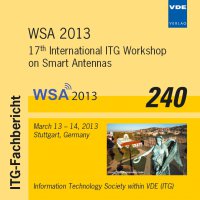Distributed IDM-STC versus Cooperative OFDM for the Two-Hop Decode-and-Forward Multiple-Access Relay Channel
Conference: WSA 2013 - 17th International ITG Workshop on Smart Antennas
03/13/2013 - 03/14/2013 at Stuttgart, Deutschland
Proceedings: WSA 2013
Pages: 7Language: englishTyp: PDF
Personal VDE Members are entitled to a 10% discount on this title
Authors:
Vorkoeper, Sebastian; Kuehn, Volker (University of Rostock, Institute of Communications Engineering, Richard-Wagner-Str. 31, 18119 Rostock, Germany)
Lenkeit, Florian; Wuebben, Dirk; Dekorsy, Armin (University of Bremen, Dept. of Communications Engineering, Otto-Hahn-Allee NW 1, 28359 Bremen, Germany)
Abstract:
This paper deals with the performance of two different access techniques for the Two-Hop Decode-and-Forward (DF) Multiple-Access Relay Channel (MARC) which includes multiple source and relay nodes. In particular, cooperative Orthogonal Frequency Division Multiplexing (cOFDM) is compared with distributed Interleave Division Multiplexing Space-Time Codes (dIDM-STC). While cOFDM requires strict synchronization in time and frequency among all communicating nodes, it allows for a rather simple detection structure. dIDM-STC, on the other hand, is very robust against timing and frequency offsets among the communicating nodes, however, requiring a more complex iterative detection. Both techniques are discussed in detail and are compared in terms of frame-error-rates (FER) and end-toend throughput by numerical evaluations.


